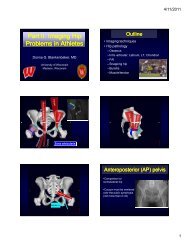Ankle and Foot 47 - Department of Radiology - University of ...
Ankle and Foot 47 - Department of Radiology - University of ...
Ankle and Foot 47 - Department of Radiology - University of ...
You also want an ePaper? Increase the reach of your titles
YUMPU automatically turns print PDFs into web optimized ePapers that Google loves.
A<br />
B<br />
C D E<br />
T1<br />
T2fs<br />
T1fs<br />
IVGd<br />
F G H<br />
Figure <strong>47</strong>-116. Brodie’s abscess in a young child. A, Anteroposterior radiograph <strong>of</strong> the asymptomatic right leg. B, Anteroposterior radiograph <strong>of</strong><br />
the swollen left leg reveals a lucency in the distal fibula metaphysis (arrow in the magnified dashed box). This lucency has a well-defined <strong>and</strong><br />
sclerotic margin, indicating chronicity. There are also thick, chronic periosteal reactions (arrowheads) extending up the diaphysis. C, Coronal<br />
T1-weighted image through the distal fibula confirms the radiographic findings <strong>of</strong> a thick chronic periosteal reaction (white arrowheads), as well as<br />
the well-circumscribed dark line (open arrowheads) around the lesion corresponding to the sclerotic margin. D, The corresponding coronal<br />
T2-weighted fat-suppressed image shows that the well-circumscribed lesion (arrow) is as bright as fluid <strong>and</strong> thus probably cystic. E, The<br />
corresponding coronal T1-weighted fat-suppressed post–intravenous (IV) gadolinium contrast image not only confirms that the lesion (arrow) is<br />
mostly nonenhancing <strong>and</strong> thus mostly cystic, but demonstrates peripheral enhancement, in some places thick (black arrowhead), characteristic <strong>of</strong><br />
an abscess, in this case an intraosseous or Brodie’s abscess. (There is inadequate fat suppression <strong>of</strong> the heel pad [large white arrowhead] on both<br />
<strong>of</strong> the fat-suppressed sequences, D <strong>and</strong> E.) F to H, Axial images through the fibular abscess reveal it to be isointense to muscle on T1-weighted<br />
image (F, arrow) <strong>and</strong> fluid bright on T2-weighted fat-suppressed image (G, arrow), with peripheral but not central enhancement on fat-suppressed<br />
T1-weighted image after IV gadolinium (H, arrow). There are edema <strong>and</strong> enhancement <strong>of</strong> the s<strong>of</strong>t tissues surrounding the fibula, indicating an<br />
active inflammatory component to this chronic Brodie’s abscess.<br />
Ch0<strong>47</strong>-A05375.indd 2311<br />
9/9/2008 5:36:20 PM
















